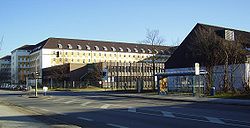Ernst von Bergmann barracks
|
|
|||
|---|---|---|---|

Main access to the Ernst-von-Bergmann-Kaserne |
|||
| country | Germany | ||
| status | Medical academy of the Bundeswehr | ||
| local community | Munich | ||
| Coordinates : | 48 ° 13 ' N , 11 ° 35' E | ||
| Opened | 1934 to 1936 | ||
| Old barracks names | |||
| 1938-1945 1950-1968 |
Barracks Munich - Freimann Warner barracks |
|
|
| Formerly stationed units | |||
|
SS regiment 1 "Germany" 24th Infantry Division military hospital group 7609 Medical Teaching Battalion 851 |
|
||
|
Location of the Ernst von Bergmann barracks in Bavaria |
|||
The Ernst-von-Bergmann-Kaserne (short: EvB-Kaserne ) is a military property on Neuherbergstrasse in the Munich district Milbertshofen-Am Hart . It was built between 1934 and 1936 by Oswald Bieber with various other architects, including Theo Lechner .
history
- Barracks Munich-Freimann (SS and UNESCO)
The barracks was the end of the Second World War as a barracks in Munich-Freimann from the SS regiment 1 "Germany" the SS-Verfügungstruppe used. After the end of the war, the barracks area was used by UNESCO ( United Nations Emergency Aid and Reconstruction Administration ) as an accommodation camp for displaced persons .
After the transit camp in the radio barracks was completely overcrowded, the International Refugee Organization decided in April 1948 to move some of the Jewish camp residents who had previously been housed there and who were destined for emigration to the barracks. While 475 Jewish residents were still housed in the emigration camp on April 9, 1948, there were eleven on October 18, and seven on July 25, 1949. The camp was closed on April 22, 1950.
- Warner Barracks (US Army)
When the US Army took over the property at Ingolstädter Strasse 193 in 1950, the property was given the name Warner Barracks . The rebuilding of the barracks cost eight million Deutschmarks . A total of 5,000 men were housed. The huge main building Building 1701 (today Building 1) was the second largest military building of the US Army after the Pentagon . A small synagogue was also set up in the barracks . Starting in 1954, the Munich-North residential complex was built around the barracks to accommodate US employees . Most recently, parts of the 24th US Infantry Division were housed there. By the end of the 1960s was on the northern border Panzerwiese the associated airfield Warner Strip .
- Ernst von Bergmann Barracks (German Armed Forces)
At the end of 1968 the barracks were taken over by the German armed forces and after lengthy renovation work - including the move to Neuherbergstrasse - renamed Ernst-von-Bergmann-Kaserne in 1971. It was named after the surgeon Ernst von Bergmann . On the occasion of the 1972 Summer Olympics , the then Academy of Medical and Health Services of the Bundeswehr had to provide a ready-to-use light hospital with 120 beds on the property. In the period from 1973 to 1980, the reconstruction took place to accommodate the Academy of Medical and Health Services of the Bundeswehr as the main user and part of the economic force, which has been called the Bundeswehr Medical Academy since 1997 .
In addition to the now-defunct medical teaching Battalion 851 and the military hospital group 7609 is Emil von Behring -House of the property the subject Medical Center Munich housed the (later Medical Center Munich) emerged from the original site Medical Center Munich. Parts of the specialist medical center in Munich of the Bundeswehr hospital in Amberg , which had been housed in the barracks since the mid-1990s , were also incorporated into the specialist medical center in Munich. The Ernst von Bergmann barracks also house the institutes for pharmacology and toxicology , microbiology and radiobiology of the Bundeswehr and, since the mid-1990s, the Center for Recruiting Young Talent, which was formerly located in the Luitpold Barracks and which became the Bundeswehr Süd career center in 2012 which has since been located in Dachauer Straße .
Trivia
The episode “Cheap Gasoline” (1961) of the TV series Funkstreife Isar 12 was filmed in the property .
See also
Web links
- Corporal comradeship in the EvB barracks
- Old photos:
Individual evidence
- ↑ Lechner, Theo. In: Werner Ebnet: You lived in Munich: Biographies from eight centuries . Allitera Verlag, Munich, 2016, ISBN 978-3-86906-744-5 , p. 361.
- ^ Munich Funkkaserne and Munich Warner-Kaserne. In: Angelika Königseder; Juliane Wetzel : Courage in life in the waiting room. The Jewish DPs (Displaced Persons) in post-war Germany. Fischer Taschenbuch Verlag, Frankfurt am Main 1994 [1. Ed.], 259.
- ↑ Ingolstädter Strasse 193. In: Benedikt Weyerer: Munich 1950-1975. City tours on political history. Geschichtswerkstatt Neuhausen , 2003, p. 70 ff. ISBN 978-3-931-23113-2
- ^ Warner barracks in Munich - Warner barracks (English).
- ^ Church Services Throughout Munich. In: The Munich American , No. 21, May 25, 1951, p. 7.
- ↑ https://www.mil-airfields.de/deutschland/muenchen-panzerwiese.html
- ↑ Major order for the Bundeswehr administration. In: Defense. Organ of the Society for Military Studies. Vol. 26, Verlag Europäische Wehrkunde, 1972, p. 403.
